It’s the biggest event ritualistically marked on the calendar of every Mongolian family, the annually celebrated and greatly anticipated Naadam festival. With origins pre-Genghis, it’s a deep-seated tradition, a powerful expression of a largely itinerant lifestyle, and a celebration of independence and culture.
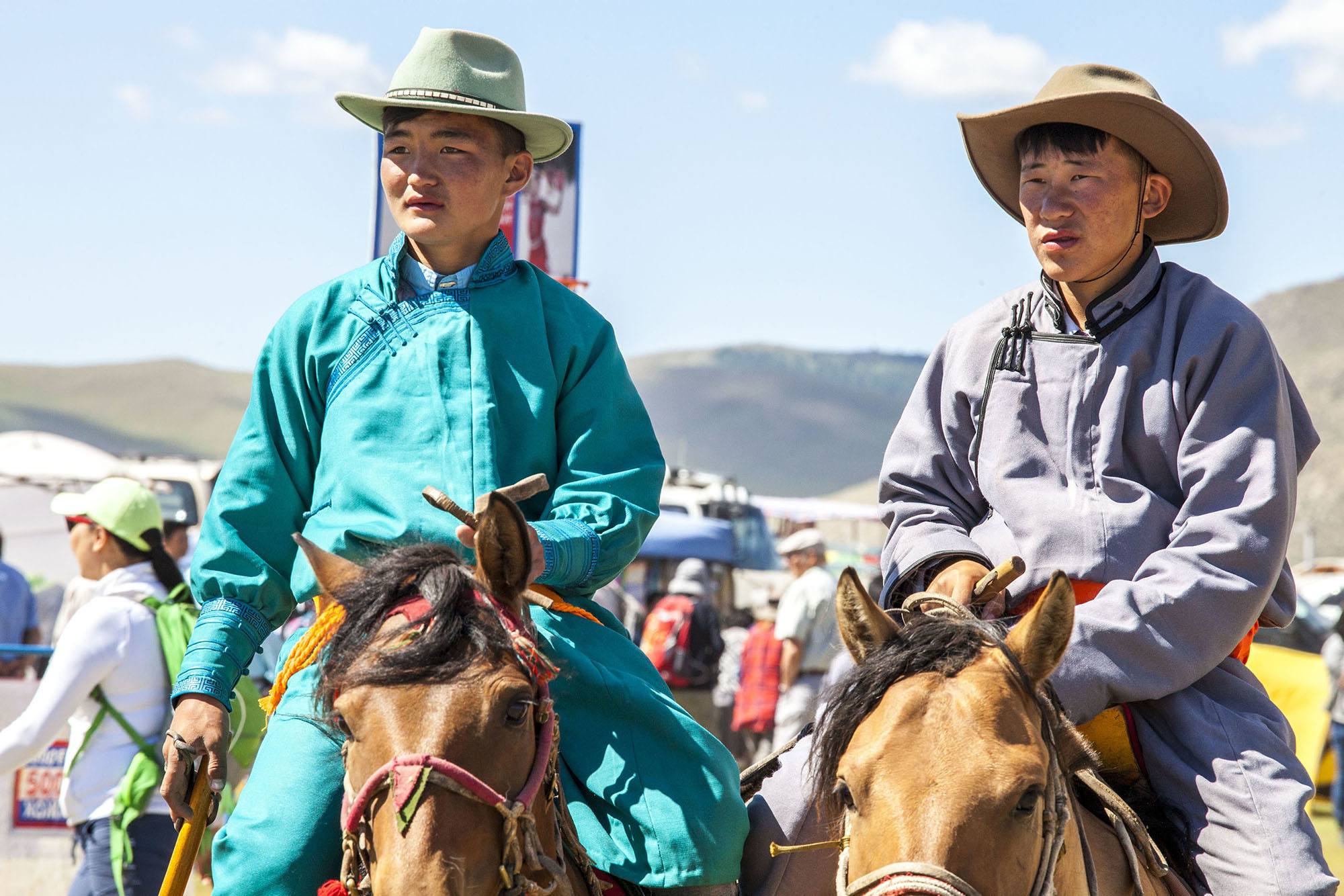
I didn’t plan my journey around Naadam, but Mongolia had other plans for me. Before I knew it, mid-Gobi Desert tour, I was standing amid a whirlwind of colour, sweat, and dust in Karakorum, watching warriors grapple and young jockeys gallop across the land. If there’s a heartbeat to this country, it’s Naadam.
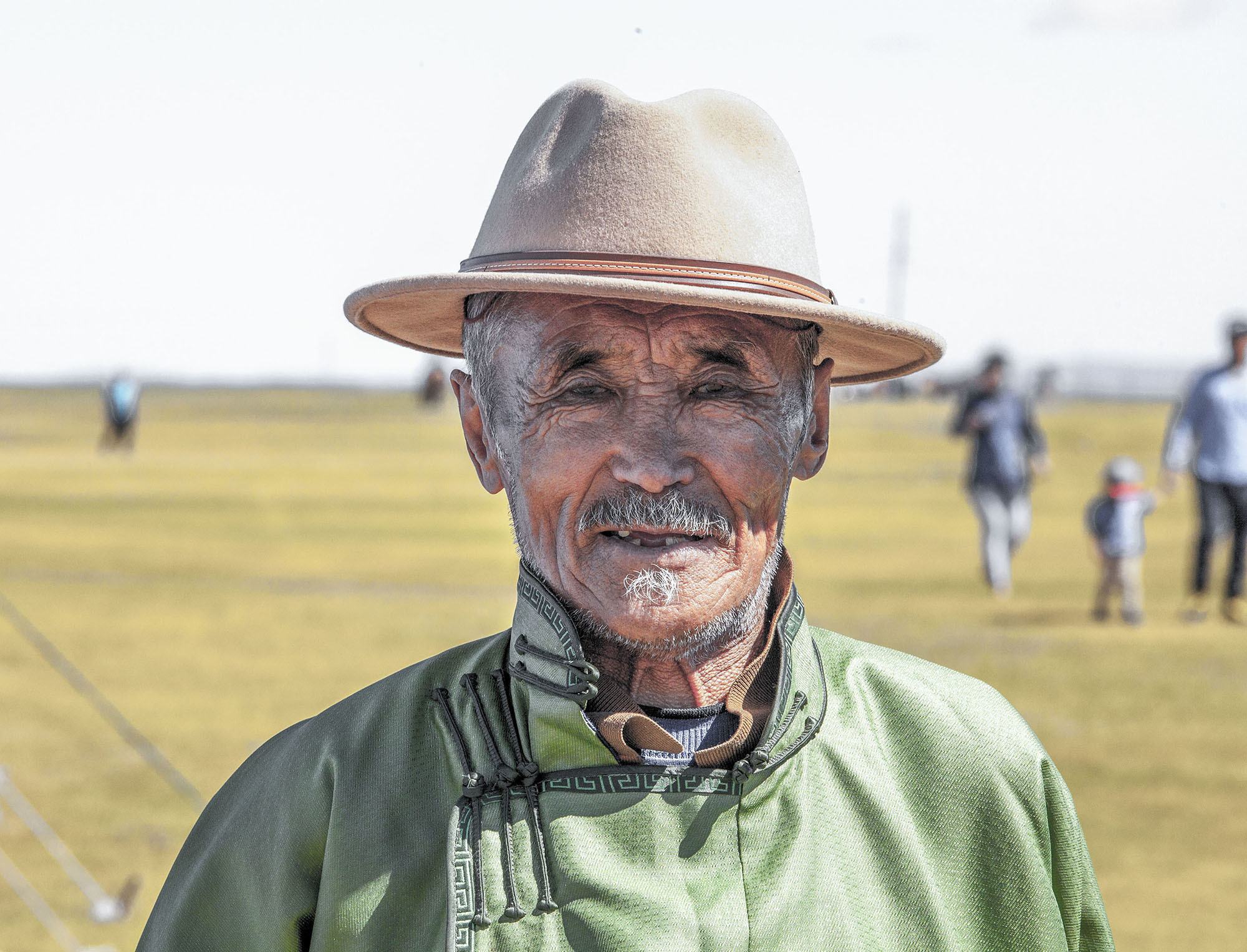
But beyond the dust and the thrill of competition, what exactly is Naadam?
📌 Quick Facts About Naadam Festival
- Where? Celebrated nationwide, with the biggest event in Ulaanbaatar
- When? Annually from July 11–13 (dates may vary slightly)
- Main Events? Wrestling, Horse Racing, Archery (and Shagai, the ankle bone game)
- How to Attend? Tickets are required for Ulaanbaatar’s stadium event, but regional Naadam festivals are free & more intimate
Here’s what else I learned and experienced.
Naadam Festival History: From Genghis Khan to Modern Mongolia
Before stadiums and fireworks, before Mongolia was even a country, there was Naadam. A test of strength, skill, and endurance, these games were preparation for survival.
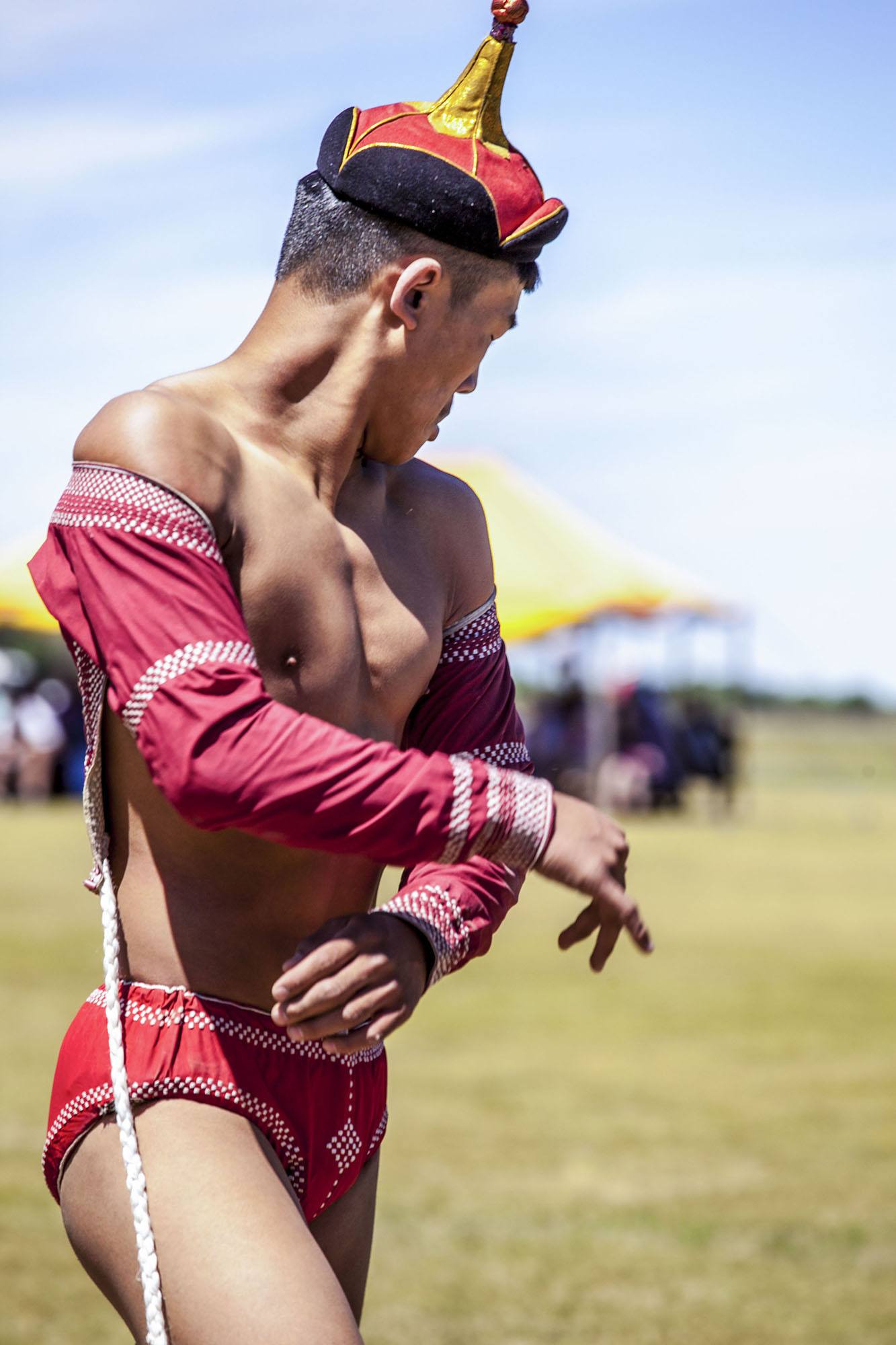
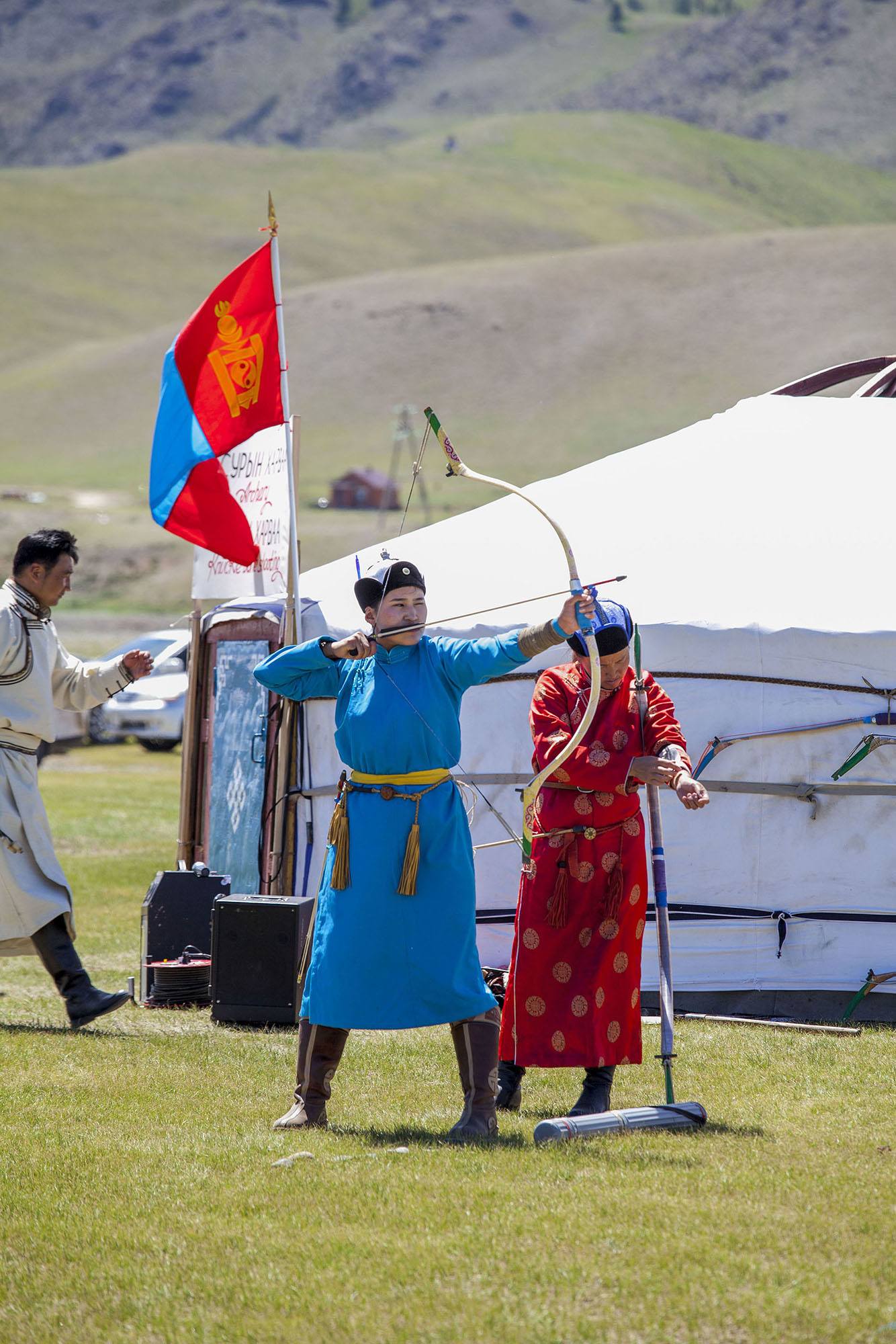
The 3-day event showcases Mongolia’s deep-rooted warrior spirit.
The name Naadam – eriin gurvan naadam (эрийн гурван наадам) – when translated, means “the 3 games of men,” a nod to the wrestling, horse racing and archery that have traditionally comprised the festival.
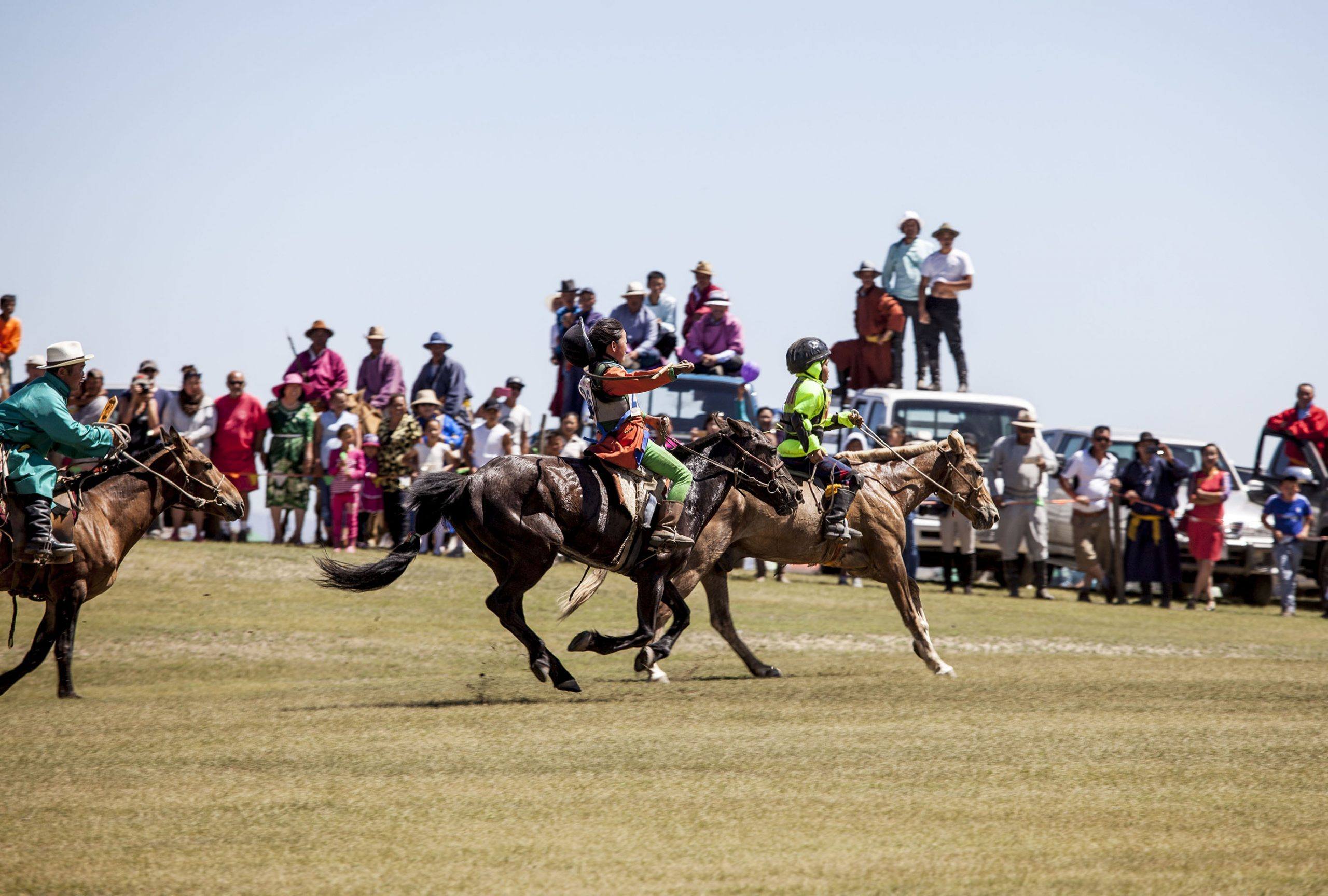
Historically, it was done as a showcase of each clan’s talent, celebrating communities. Under controversial leader Genghis Khan, it became a way of training soldiers, ensuring they were well prepared for battle.
Throughout history, it’s been used to inaugurate sporting events, spiritual gatherings and even weddings. Now, it’s an official celebration of the Mongolian Revolution and the independence in which the nation revels.
Save this article for future reference!
Naadam Festival Costumes: A Display of Tradition and Symbolism
Unlike many ancient cultures, Mongolia’s Naadam Festival is marked by vibrant traditional attire, worn as a tribute to heritage and celebration. Each sporting discipline within the festival has its own unique clothing and symbolism, reflecting both history and philosophy.
The Deel: Mongolia’s Traditional Robe
The deel is the most iconic Mongolian garment, worn by both men and women during Naadam. This tunic-like robe, crafted from cotton, wool, or silk, fastens at the right side with decorative clasps and flares out at the base, creating a striking visual effect as the wearer moves.

During Naadam, the deel transforms into a kaleidoscope of colour, its bold hues shimmering under the Mongolian sun. Nowhere is this more mesmerising than in the horse racing events, where young jockeys — some as young as 5 — ride at full speed, their deel billowing behind them in a blur of movement and tradition.
Naadam Wrestling Attire: A Costume Steeped in Controversy
Unlike the deel, Naadam wrestling uniforms have a unique and storied history — one shaped by tradition, practicality, and even scandal.
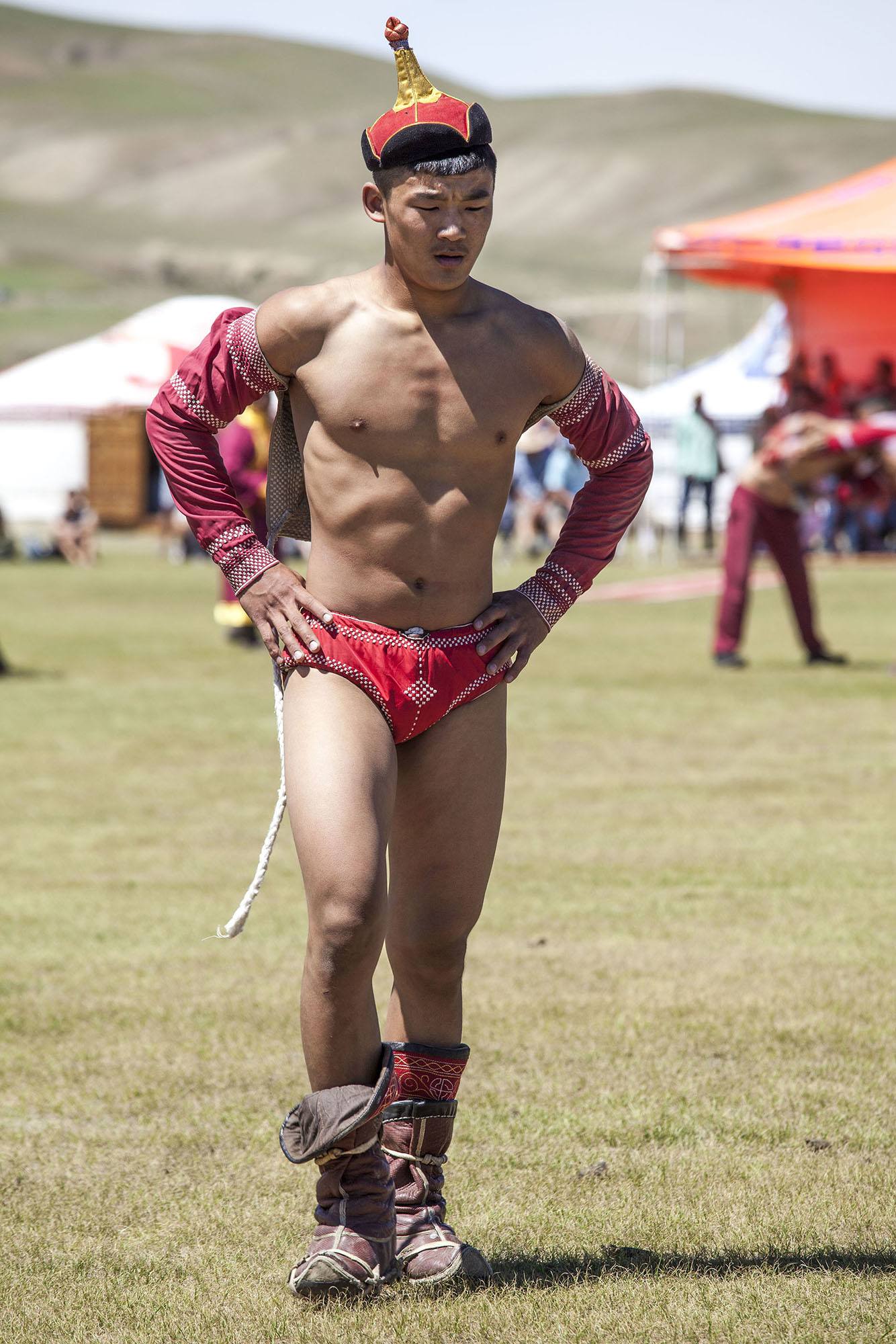
Historically, Mongolian wrestling attire fully covered the chest. However, folklore tells of a female Amazonian warrior who once entered the competition disguised as a man. She outperformed her male counterparts, winning the tournament and shocking the spectators.
To prevent this from happening again, the zodog — the traditional wrestling vest — was redesigned to be open at the chest, ensuring that only men could compete. The resulting uniform, worn to this day, consists of:
- Zodog (Shoulder Vest): Open-chested, long-sleeved, and snugly fitted to the body.
- Shuudag (Shorts): Tight-fitting red or blue briefs.
- 4-Sided Hat: A symbol of Mongolia’s 4 historical provinces.
- Traditional Boots & Cloak: Completing the ceremonial ensemble.
The evolution of wrestling attire is just one example of how Naadam preserves Mongolia’s past while continuing to evolve. Each element, from the symbolic hat to the practical zodog, reflects a deep cultural identity — one that is proudly displayed during this festival of strength, endurance, and tradition.
Naadam Festival: Ceremonies and Traditional Games
Naadam Festival is more than just a sporting event — it’s a celebration of Mongolian culture, history, and national pride.
The festival officially begins with an elaborate opening ceremony before leading into its legendary "3 Games of Men" — wrestling, horse racing, and archery. A lesser-known but more recent addition, Shagai (ankle bone flicking), rounds out the event. Finally, a closing ceremony honours the victors and brings the festival to a grand conclusion.
Opening Ceremony: Naadam's Grand Spectacle
Held in Ulaanbaatar, the colourful opening ceremony lasts 3 hours and is hosted by the President of Mongolia. The spectacle includes:
- Horse-riding demonstrations
- Athletic performances
- Historical re-enactments
- A procession of speeches, khoomei (throat singing), and flag-waving
It’s a powerful display of Mongolian identity, setting the stage for the intense competitions to come.
I wasn’t in Ulaanbaatar to witness the grandeur firsthand, but I daresay it’s a riotous and electrifying way to kick off the festival.
Naadam Festival Games: Wrestling, Horse Racing, Archery & Shagai
At its heart, Naadam is a showcase of strength, endurance, and precision, featuring Mongolia’s most cherished sports.
Naadam Festival Wrestling: Bökh, Mongolia’s Most Prestigious Sport
Bökh — the very essence of Mongolian masculinity — is the most prestigious and time-honoured sport of Naadam.
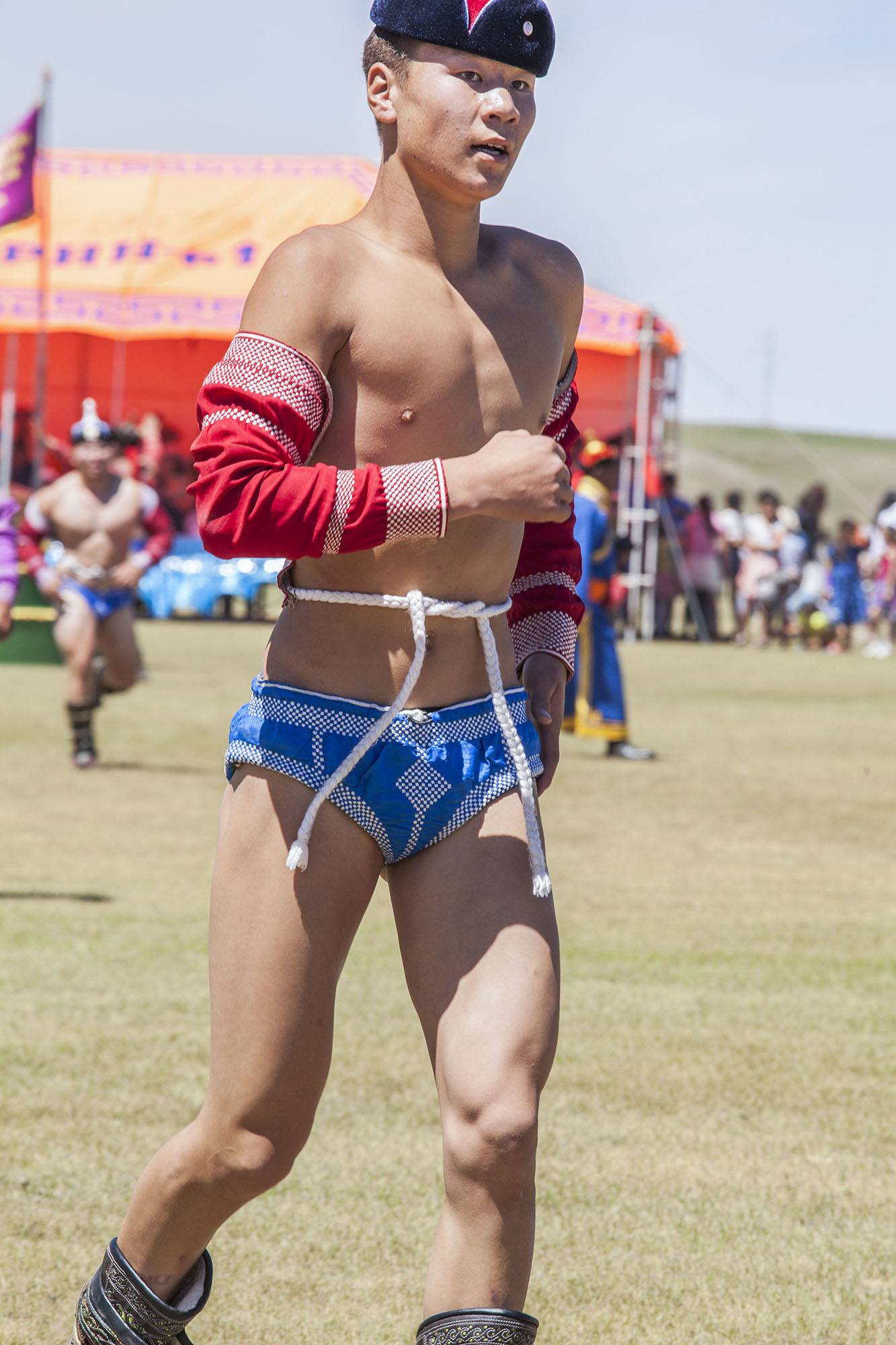
Meaning “durable”, the word itself embodies the unyielding spirit required to wrestle at Naadam. Wrestling is so deeply ingrained in Mongolian culture that when a male child is born, families often wish for him to become a wrestler — a testament to the status it holds in society.
▶ The Atmosphere: A Carnival of Strength
The energy in Karakorum was electric. I found myself swept into the frenzy, jostling through the crowd until I landed between two exuberant Mongolian men, their excitement palpable.
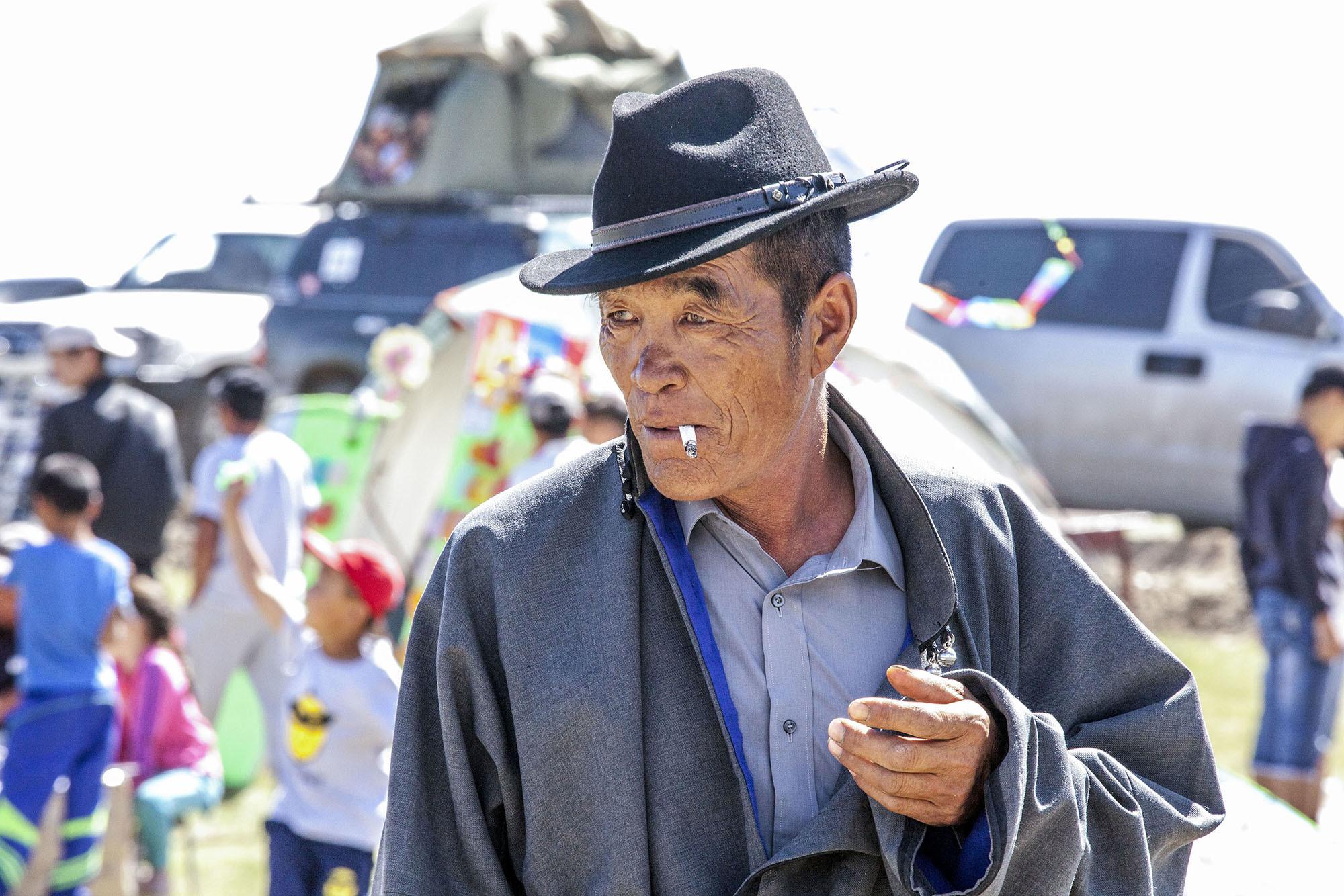
This was more than just a competition — it was a national spectacle, a showcase of power, agility, and legacy.
▶ No Weight Classes, No Limits
Unlike Western wrestling, Naadam’s Bökh has no weight categories. A lean, wiry fighter can face off against a massive, towering opponent, making it a true test of technique over brute strength.
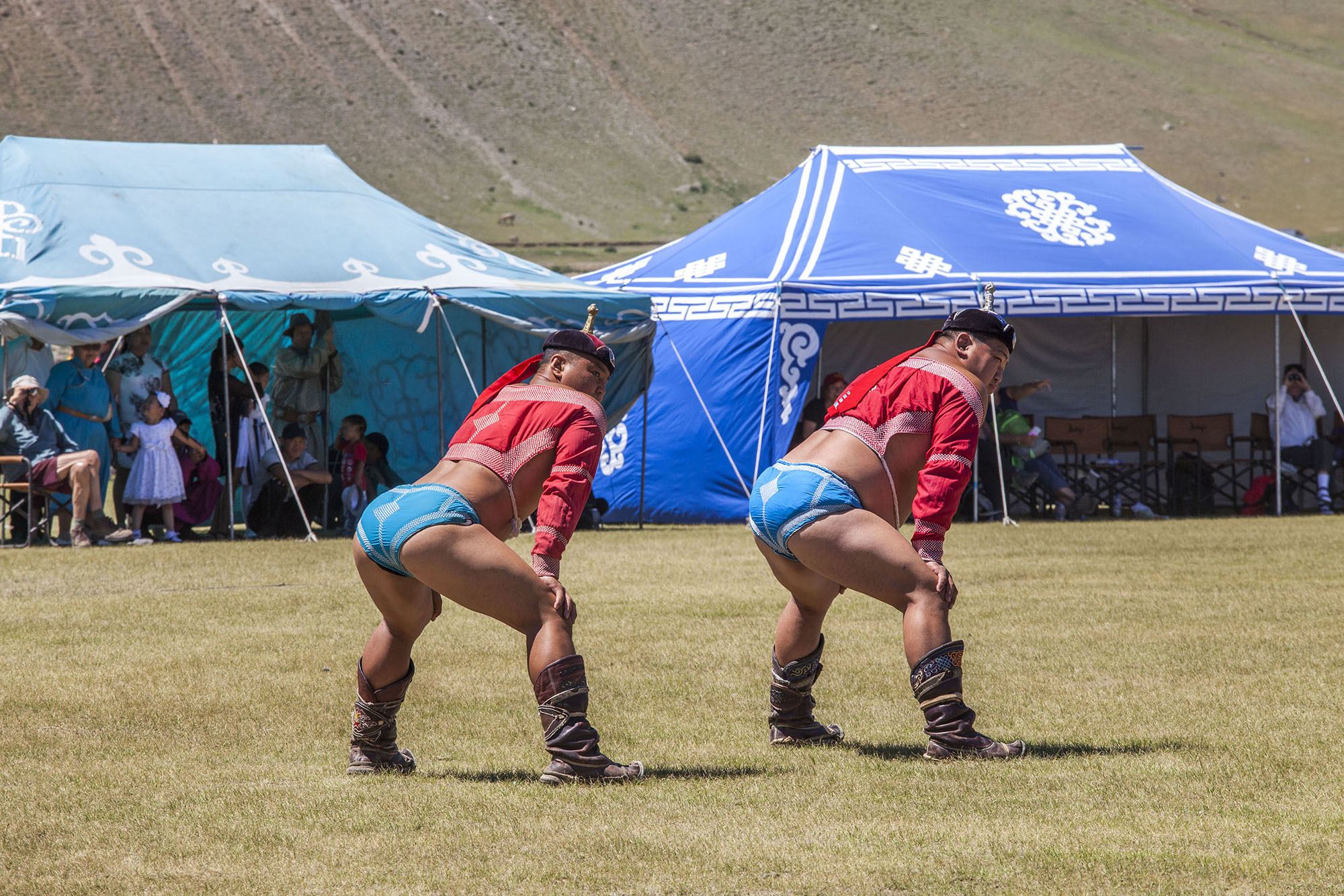
This unpredictability is part of what makes watching Naadam wrestling so exhilarating.
As the competitors emerged from their sideline tents, they began shedding their ceremonial gowns. The midday sun glistened off their bare torsos, their bodies covered only by zodog, shuudag, and 4-sided hats.
▶ Buh Tavih: The Eagle’s Dance
The moment before battle is sacred. As the wrestlers step onto the field, they do more than stretch — they channel centuries of tradition. Arms spread wide, backs arched like eagles in flight, they perform 'Buh Tavih' — a warm-up and a declaration of dominance.
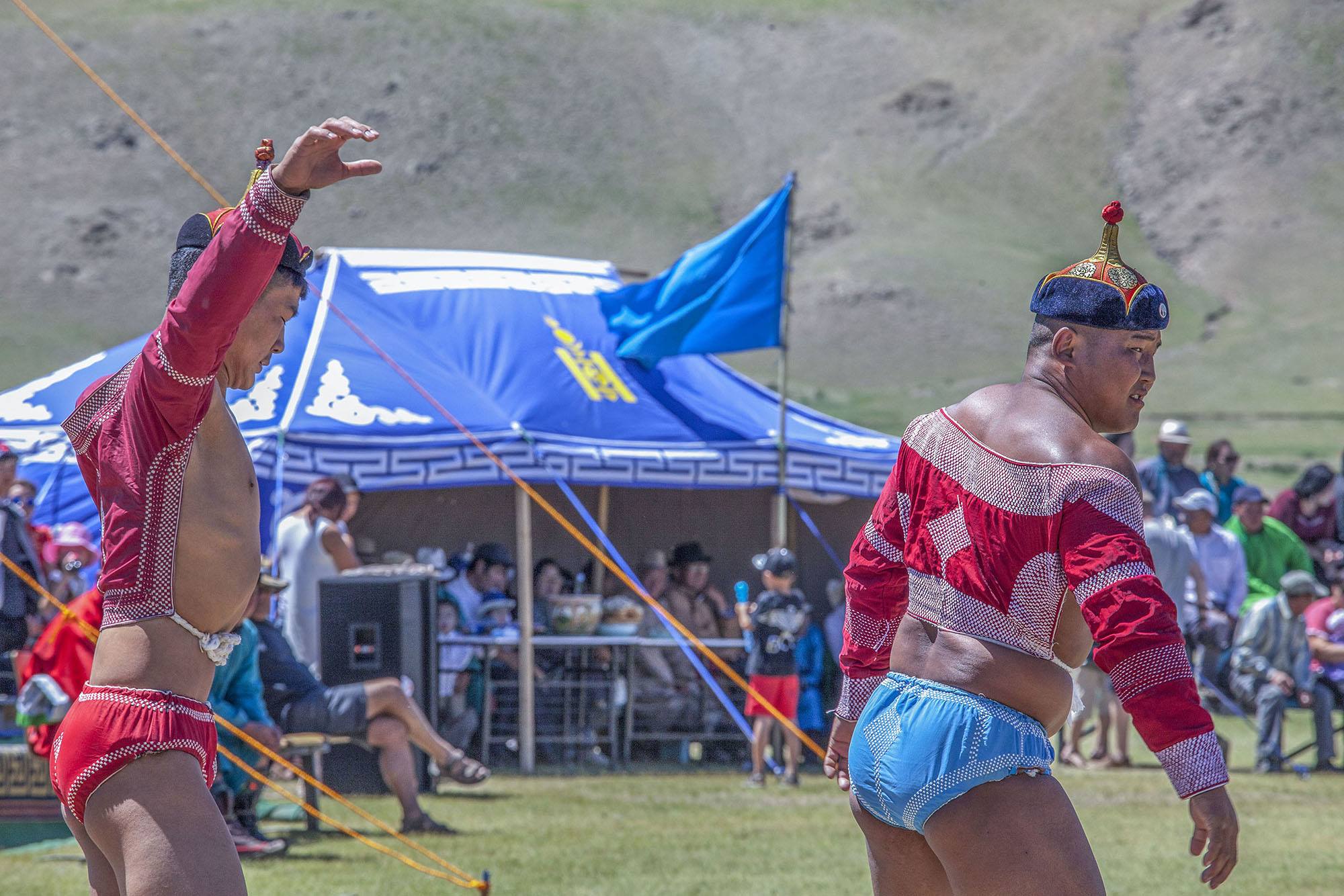
The ritual symbolises the hunt, the pursuit of victory.
As the first matches commenced, the tension in the air was thick. Wrestlers lunged, twisted, and grappled, their bodies locked in combat. The crowd roared, children sat perched on their parents’ laps, and cameras clicked frantically, capturing the spectacle.
▶ The Rules of the Game
With no time limits and no points system, victory in Bökh comes down to one decisive moment — the instant a wrestler’s elbow or knee touches the ground.
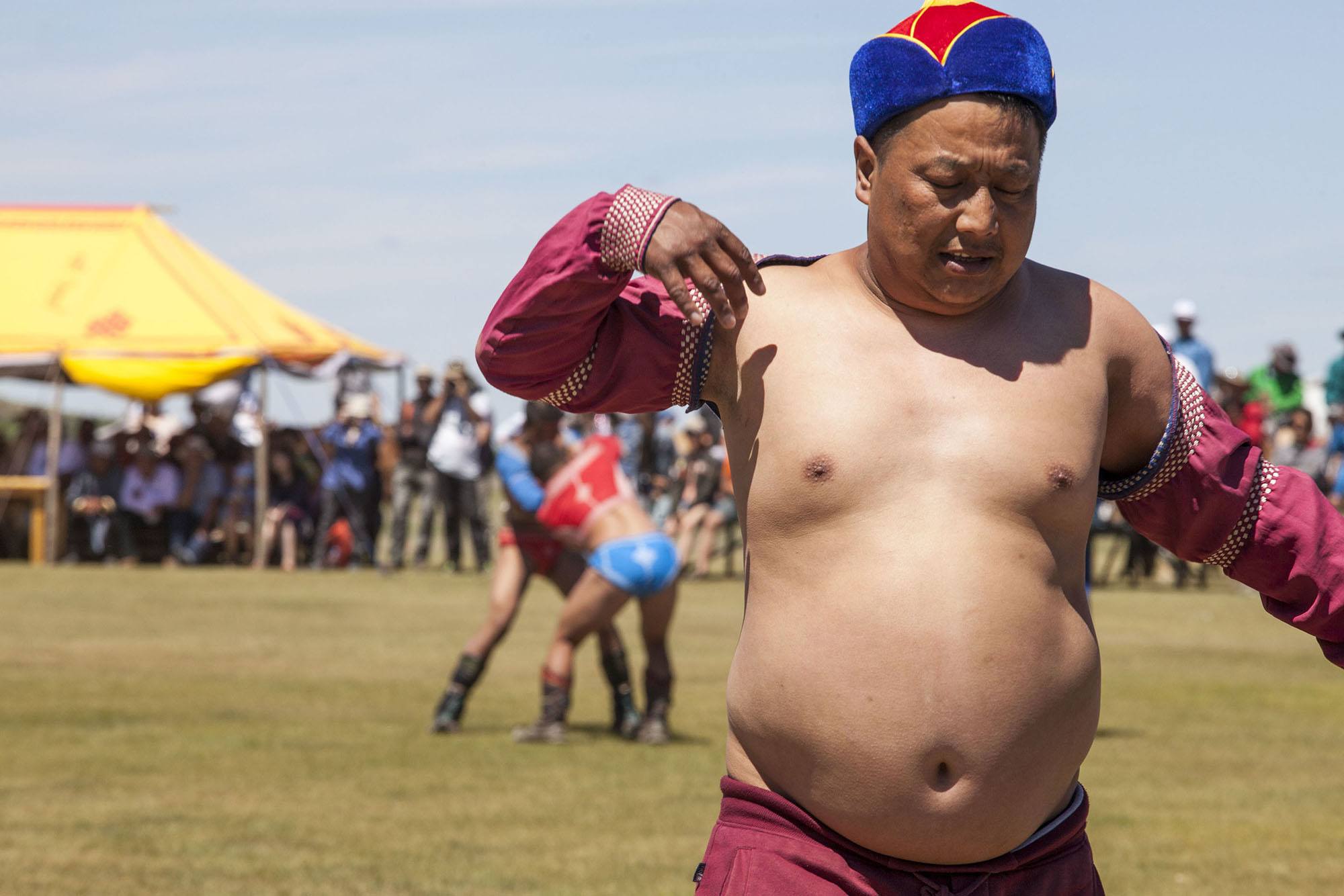
I also noted that hands touched every part of opponents’ bodies, except their heads (which I later learned is sacred to Mongolians).
I was naïve to assume the biggest and most muscular wrestlers would win and quickly realised that pure strength alone wasn’t enough. The smaller, faster wrestlers darted around their heavier, bulkier opponents, using agility and technique to outmanoeuvre them. Watching them, I understood: Bökh isn’t just about force — it’s about strategy, endurance, and control.
Picking a winner, for me, was the second greatest challenge.
The biggest challenge was trying to comprehend the rules without understanding the language.
▶ A Dance of Power and Precision
At times, the matches resembled a choreographed dance, a ballet of tactical footwork and lightning-fast reflexes. But then, in a flash, a wrestler would lift his opponent clean off the ground, sending him crashing shoulders-first into the earth. The cheers erupted, dust billowed into the air, and another match was decided.
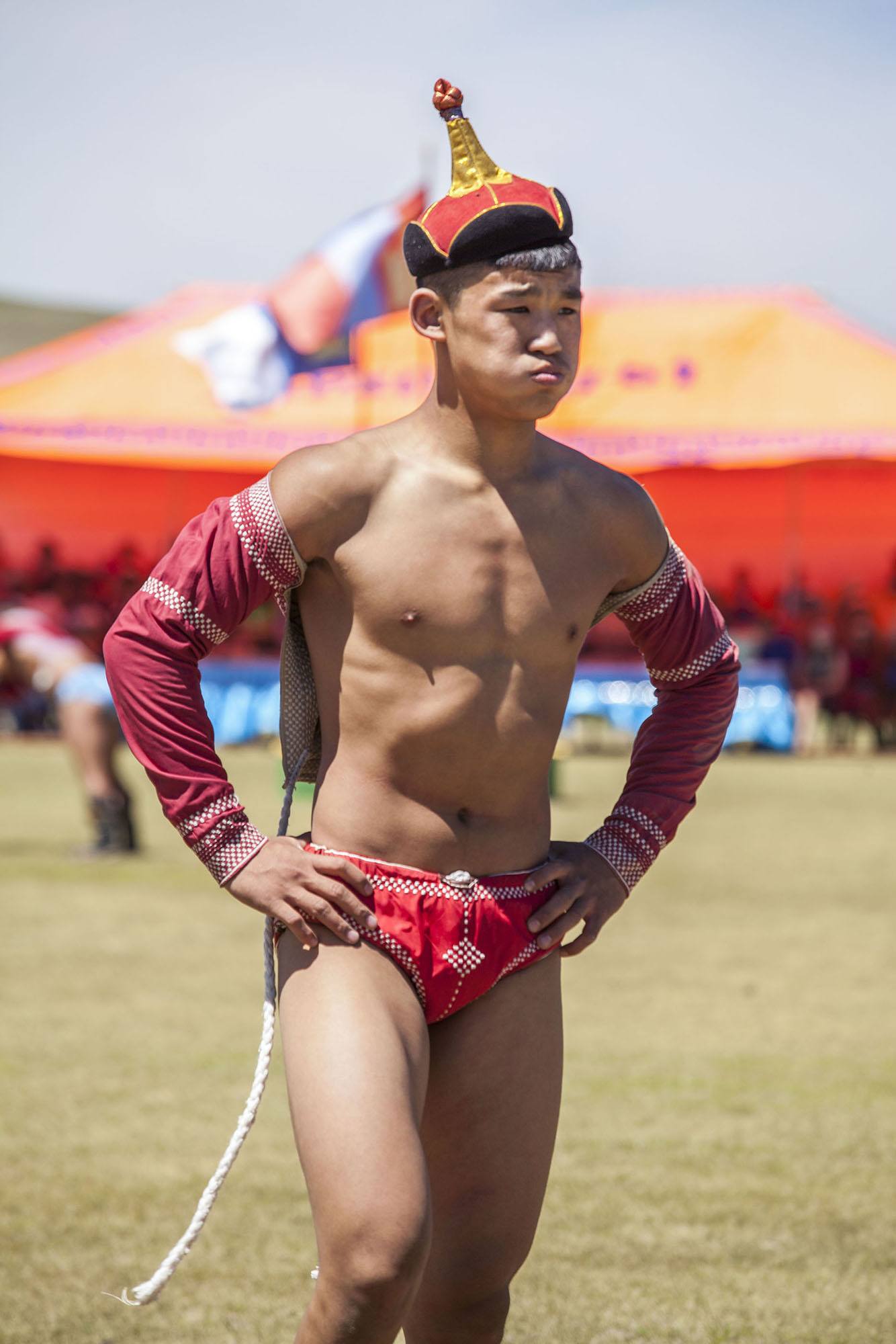
Naadam wrestling is a living testament to Mongolia’s warrior past. From the eagle-like opening stance to the final, crushing takedown, Bökh remains a spectacle of strength, precision, and deep-rooted tradition.
Naadam Festival Horse Racing: Speed, Stamina & Young Jockeys
Naadam’s horse racing events are not just about the jockeys — but about the horses.
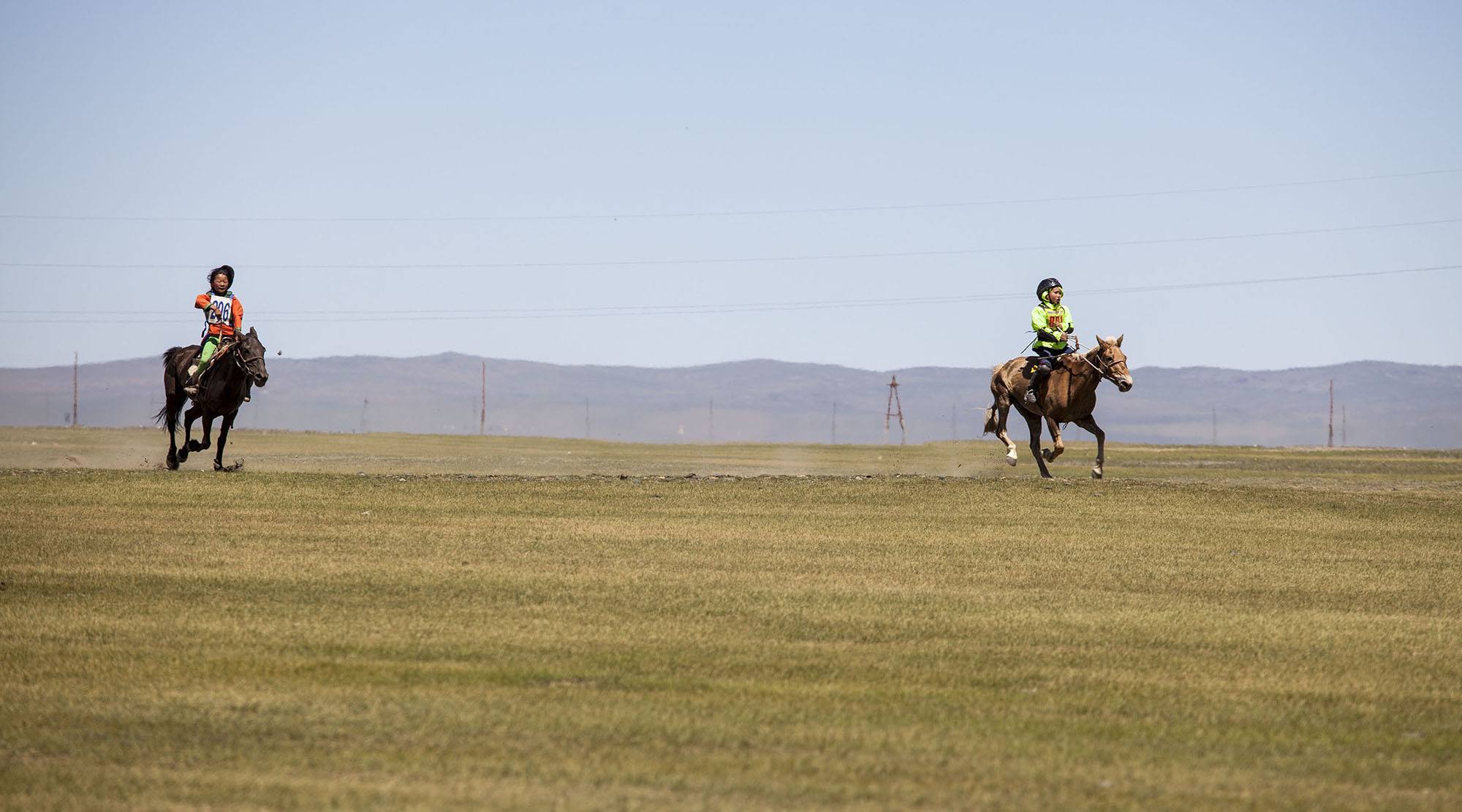
Unlike Western-style races, Mongolian horse racing tests endurance over 15 to 30 kilometres in an open-country setting.
▶ Key Features of Naadam Horse Racing
- Horses are divided into 6 categories based on age.
- Jockeys are children, often between 5 and 13 years old.
- Girls can now participate, though I didn’t see any in Karakorum.
The thundering of hooves and the rhythmic pace of galloping horses sent vibrations through the ground as the crowd erupted in cheers.
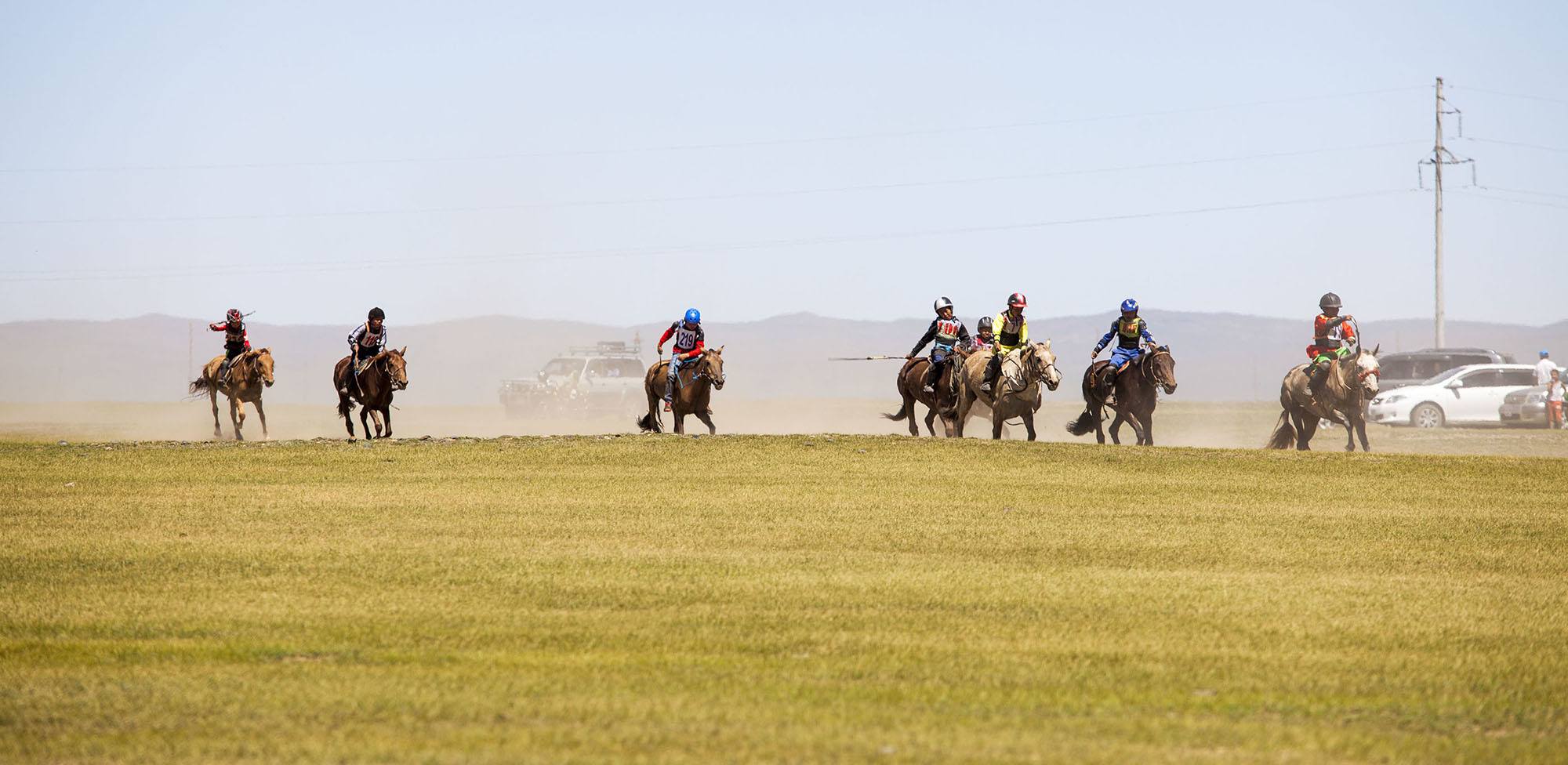
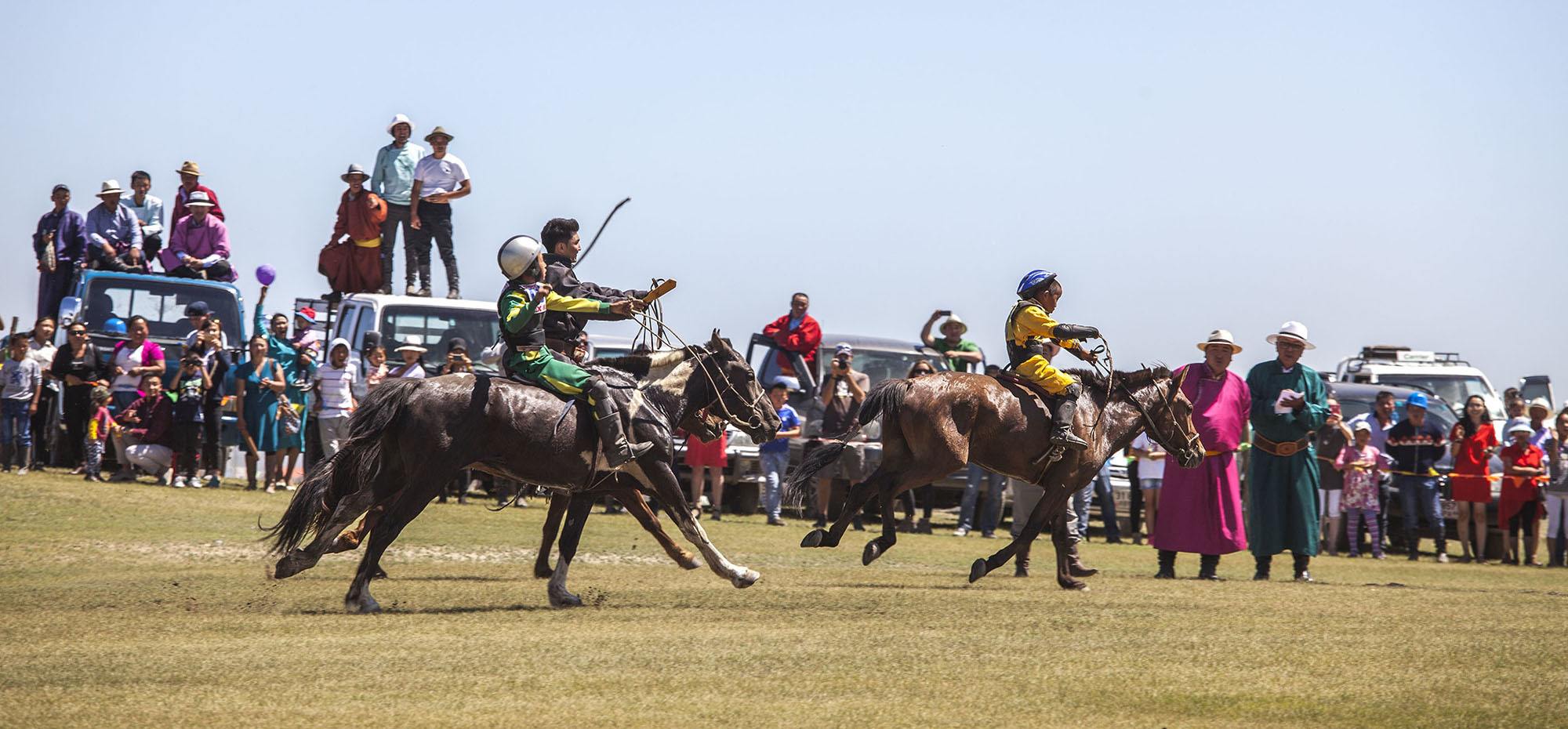
The excitement was palpable, a surge of energy moving in sync with the racing stallions.
Naadam Festival Archery: A Test of Precision
Unlike wrestling and horse racing, archery is less about physical endurance and more about skilful precision.
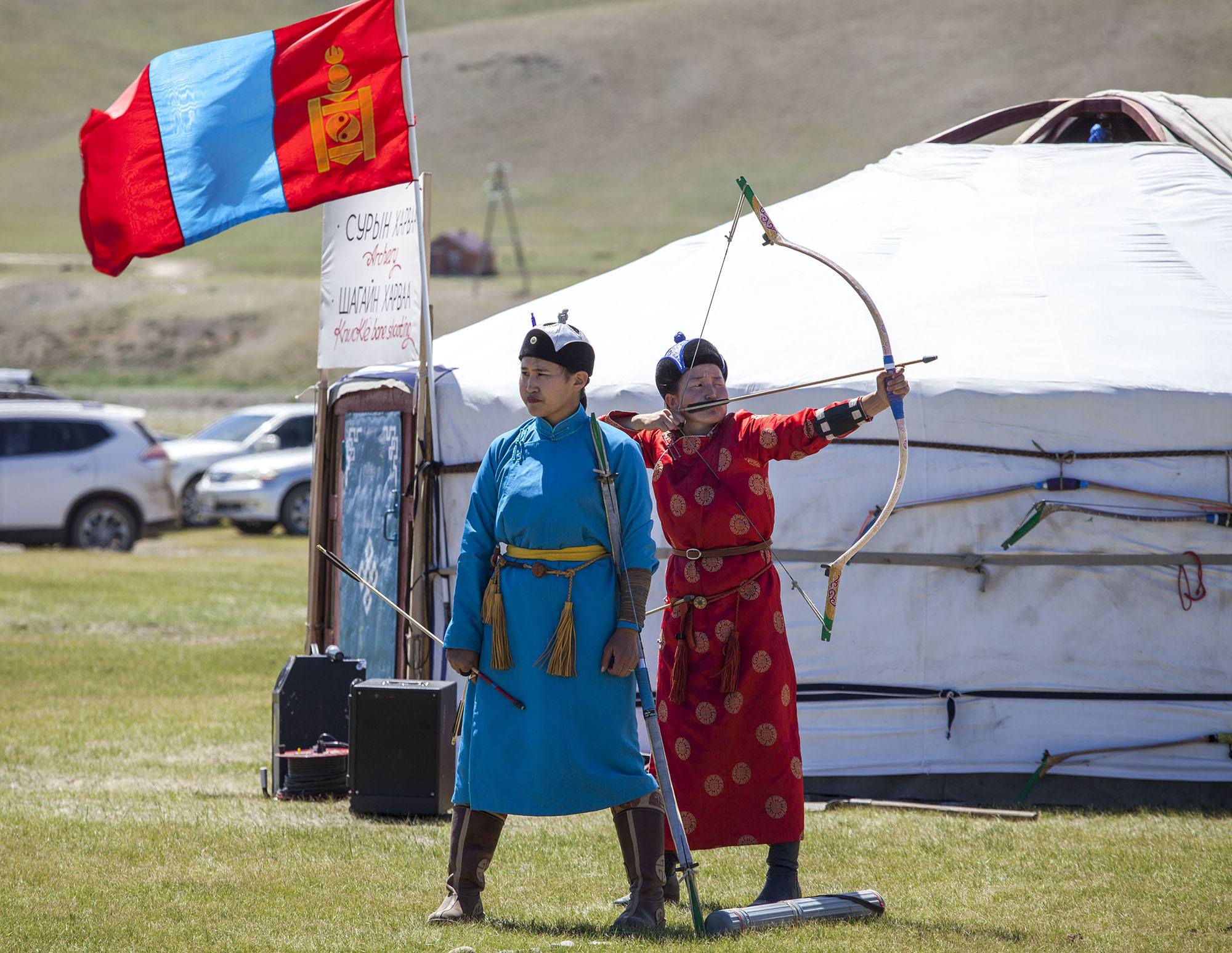
Every movement is deliberate, each archer drawing their bow with measured control, eyes locked onto the distant target in absolute focus.
▶ How Naadam Archery Works
- Both men and women compete, aiming to earn the title of "national marksman" or "national markswoman".
- Each team of 10 archers gets 4 arrows per round.
- The goal? To hit the target 33 times for team advancement.
While not as fast-paced or chaotic as the other sports, the archery event had a hypnotic allure.
The field was quiet. The twang of bowstrings cut through the air, followed by the soft thud of arrows hitting their mark. Archers, clad in deel robes, never flinched — each shot an act of centuries-old precision.
I found myself watching the shimmering deel robes of competitors more than the sport itself — perhaps a testament to Mongolia’s ability to blend aesthetics with tradition.
Naadam Festival Shagai: The Art of Ankle Bone Flicking
A newer addition to Naadam, Shagai (ankle bone flicking) became an official event in the 1990s.
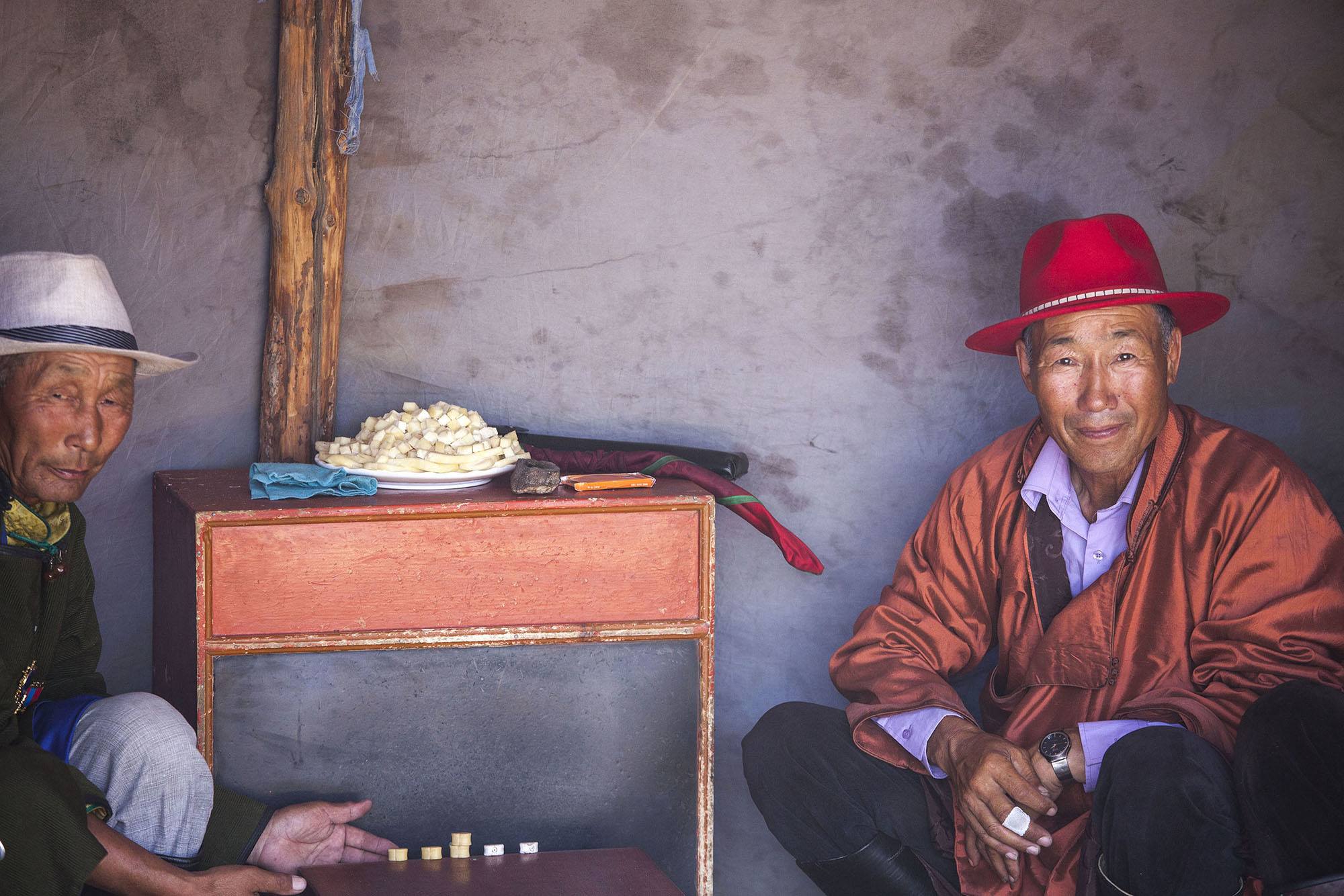
It was the final activity I saw on the annual day of festivity
▶ How Shagai Works
- Players sit 5 metres away from a pile of stacked sheep ankle bones.
- Using a small disc (soum), they attempt to flick the bones off the pile.
- Judges observe, restocking the pile after each turn.
It’s an intriguing game that combines precision and patience, and though it may not attract the same thrill as wrestling or horse racing, it holds a unique charm of its own.
I wasn’t sure what to expect from Shagai, but as the first flick sent an ankle bone flying, the crowd’s reaction told me everything — this was no mere child’s game. It was a contest of nerves, patience, and uncanny precision.
There are multiple variations and rules to boot, so ask a local sitting nearby to explain.
Closing Ceremony: Honouring the Champions
As Naadam draws to an end, final wrestling matches determine the champion, while the top 3 horses and the best archers are honoured with medals.
The closing ceremony brings the festival to an emotional high, featuring:
- A ceremonial procession to Chinggis Square in central Ulaanbaatar.
- A grand fireworks display.
Of course, each regional Naadam celebration has its own unique version of this final farewell to the games.
Traveller Tips for Experiencing Naadam Festival
Albeit only for a day, my time spent at Naadam was by far one of the most rewarding travel experiences I’ve had to date. It was an authentic taste of nomadic life on accessible display, a slice of Mongolia for voyeuristic eyes and those wanting to engage more closely with tradition and culture.
In order to enjoy a similar experience, here are a few things I’d advise you to consider:
- Watch Naadam at a soum (a regional capital). It’s more authentic than attending it at the stadium in Ulaanbaatar, there’s little drama and the opportunity to get up close and personal with each activity is real – there are few prohibitions.
- It can get very hot during this season throughout the country. Ensure you come bearing a hat, sunglasses, sun lotion and plenty of water.
- In Ulaanbaatar, the horse racing takes place at a different location to the other sports. You’ll need to take a taxi from the stadium to Hui Doolon Khutag. However, in regional Naadam celebrations, the horse racing (at least the finish line) is generally within walking distance of the other spectator sports.
- If you’re not a fan of Mongolian cuisine, then ensure you take plenty of supermarket snacks to last the day. Food stalls abound (even at regional Naadam celebrations), yet options are generally limited to khuurshuur, a deep-fried meat pastry and airag, fermented mare’s milk.
- Photographers should take a telephoto lens (for those with DSLR cameras) or a digital automatic with a decent zoom. The close-up pictures I captured of the wrestlers turned out to be my favourites.
Final Thoughts on Naadam’s Spectacle
Even now, when I think of Mongolia, I hear the roar of the crowd, the pounding of hooves, and the triumphant stance of a wrestler just before victory. Naadam Festival is a glimpse into the heart and soul of Mongolia.
Sitting in the crowd at Karakorum, flanked by lively Mongolian men who cheered with every takedown, I felt the unshakable pride that pulses through this nation.
Watching the wrestlers circle each other like eagles, witnessing the thundering rush of young riders guiding their horses across the land, I understood — Naadam is a living, breathing celebration of resilience, strength, and tradition.
I may not have been in Ulaanbaatar for the grand spectacle, but in the dust and energy of the regional Naadam, I found something even better — a raw, unfiltered connection to Mongolian heritage.
Long after the dust settles, Naadam lingers — not just in the memory, but in the pulse of Mongolia itself. The festival is a testament to the unbreakable spirit of the ancient land.
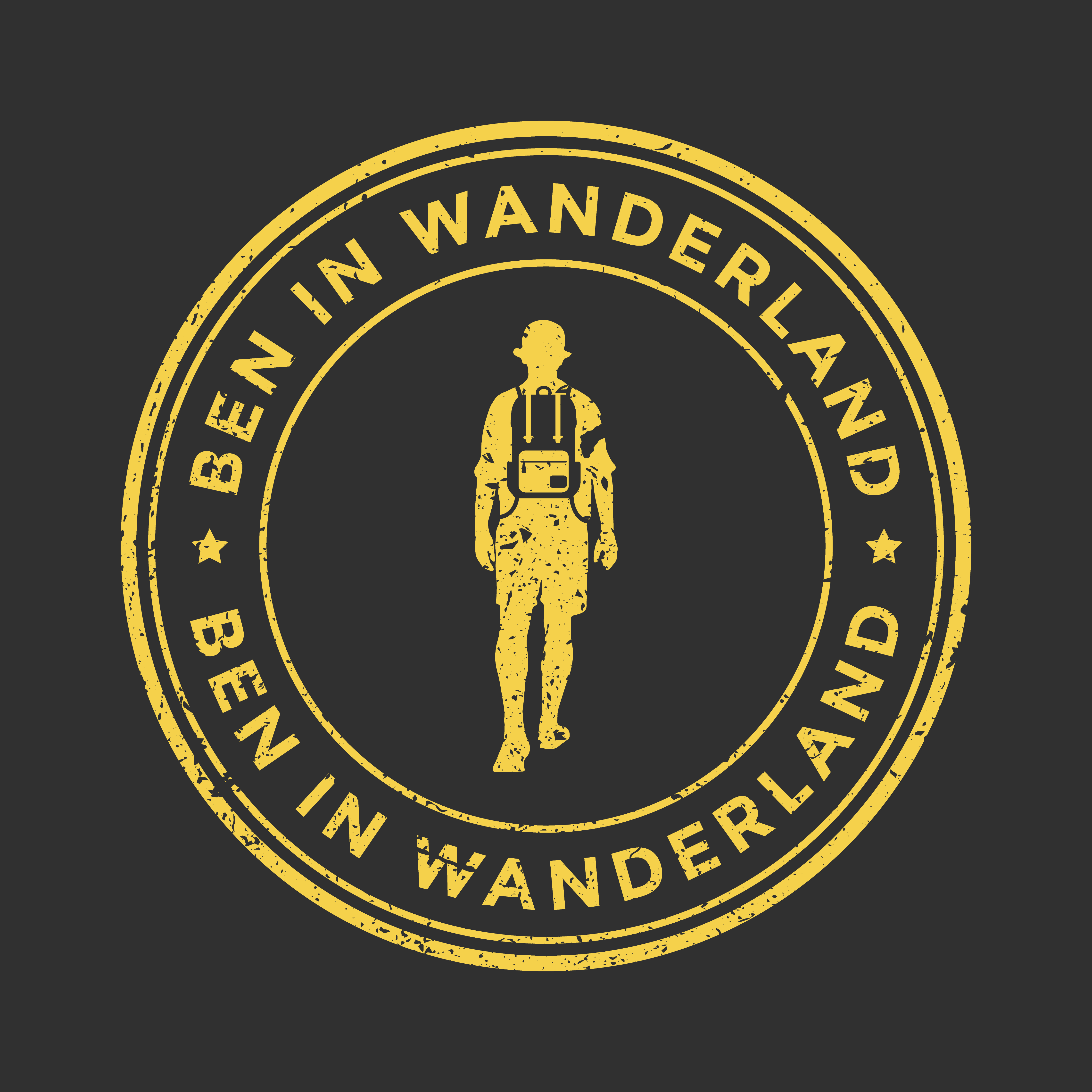


















So interesting and informative! Love the photos 💕
Hi Mandi (aka mum),
Thanks for providing lovely feedback. I always value your opinion.
Ben